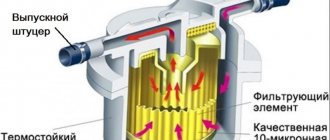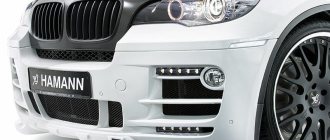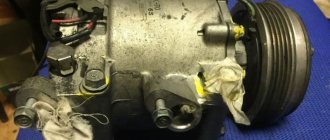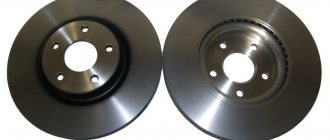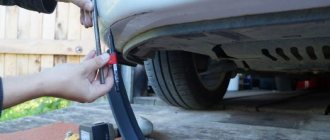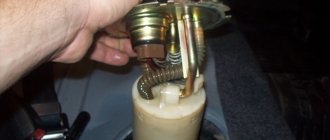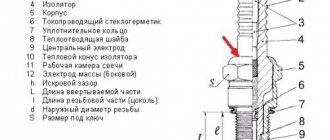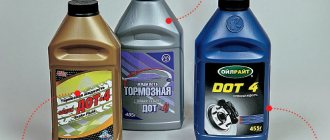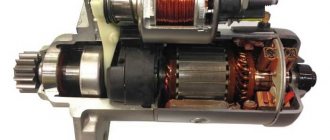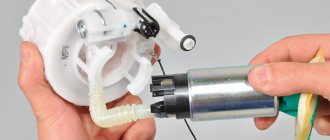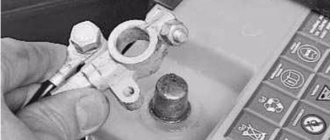Many novice car enthusiasts are often interested in the question of when to change the fuel filter. It is important to know what it is. This element purifies gasoline before it enters the engine cylinders. Clean fuel means reliable machine operation. What does the filter protect against? It's no secret that the fuel at our gas stations is not of high quality. Gasoline contains sand, rust, metal scale - all this settles on the filter. If these substances get into the engine, the main parts will wear out much faster.
As a result, the owner will need major repairs. In addition, oxidized sulfur, or rather sulfuric acid, which is formed during the combustion process, has a detrimental effect on metal surfaces. A normally functioning fuel filter completely captures various dirt and dust, condensation, rust, and paraffin inclusions. A dirty element must not be used. And if the car owner is wondering whether to change the fuel filter or clean the old one, it definitely needs to be changed. If you ignore the regulations, problems with your car will not take long to appear. Stable engine starting will be disrupted, and damage to various elements of the injection system is possible. A clogged element leads to carburetor clogging, increased fuel consumption, and a drop in engine power.
Fuel filter
, and in English it sounds like Fuel Filter - this filter element of the fuel system is designed to filter out particles of dust, dirt, debris and rust from the fuel mixture to prevent them from penetrating the fuel supply system. This avoids the creation of plugs in the fuel pipes, as well as clogging of the injectors.
When is it obvious that the fuel filter needs to be replaced?
The filtration system provides two levels of purification: coarse, removing all large particles, and fine. Fine filters are installed between the engine and the fuel tank. Experts advise replacing filters every 60 thousand kilometers. After all, their clogging leads to very serious consequences, for example, there is an additional load on the gas pump, and it can fail much faster. Clogging also causes the engine to not operate properly because fuel is not supplied to the system as it should.
Thus, the car starts to stall, stalls, and sometimes may not start at all; incorrect gear shifting also occurs (in the case of an automatic transmission, i.e., the automatic stops correctly interpreting engine commands to shift and carries them out at the wrong time or does not respond at all). But, in order not to bring the situation to such a critical moment, you can check whether the fuel filter needs to be replaced. At low speed, sharply press the gas pedal; if the car does not accelerate or there are jerks, it means that the filter needs to be replaced .
Why do you need a filter?
The main purpose of the filter is to clean the fuel from dust, dirt and foreign inclusions, which are always present in low-quality fuel. These unwanted components slowly “kill” the engine, acting as an abrasive on internal parts and deteriorating the chemical composition of gasoline.
The cleaning principle is simple - passing through the filter, the fuel seeps through several layers of filter material. In the case of diesel fuel, a separator is also used to separate water.
Purchasing a new item
When choosing this element, be sure to pay attention to the following parameters:
- filtration level. If it is insufficient and large particles nevertheless penetrate into the system along with the fuel, this will very quickly lead to engine failure;
- the area of the filtration element, as well as the presence of a rubber seal that covers the entrance to the filter itself. If there is none, this part will be very problematic to replace.
Depending on the fuel system, fine filters are divided into:
- carburetor, permissible degree of purification is 15-20 microns (smaller particles will pass into this system, but will not harm the fuel delivery system to the engine);
- injection, finer degree of purification, 5-10 microns (in such systems, the requirements for the maximum size of permissible contamination are higher, i.e. the injector can become clogged with larger particles, so the holes in the filter are smaller);
- diesel engines are capable of retaining not only very small solid particles (less than 5 microns), but also removing moisture, and this is very important for a diesel engine.
When purchasing, it is important to tell the seller the make and year of your car in order to choose the right filter. For the most part, if there is no product specifically for your case, then you can choose something interchangeable. But there are cases where this is not possible, so check your vehicle's manual for this information.
BIG Filter
Domestic BIG Filter filters are produced in St. Petersburg. They are supplied to the aftermarket and to assembly lines of domestically assembled foreign cars; production has the necessary certificates and occupies a good position in the industry. The assortment is rich and includes both products for domestic cars and a developed line for use on foreign cars.
The GB-3132 series filter is designed for French cars, including the extremely popular Renault Logan. The filter is supplied in a box with a proprietary design. The quality of printing and assembly is excellent. On the packaging you can find information about the manufacturer, contact information, production certification data, a QR code leading to the main page of the company’s website, as well as a sticker with the filter model and a short list of applicability. The filter is cylindrical, made of aluminized steel. The connections are quick-release, there are no clips included, plugs are installed. The body contains information about the manufacturer and model of the filter, and there is an arrow indicating the direction of flow. Additionally, the fittings are marked with IN and OUT stamps. The rolling of the body is rough and uneven.
The filter model GB-306 is suitable for many European cars from the 90s. It is packaged in a branded box, like other models of the manufacturer, and information about the filter model and applicability is on a sticker. The filter itself is large in size, the housing is made of aluminized steel. Clamp fastenings and pipes are closed with hard plastic plugs. Only information about the manufacturer and model is printed on the case. The flow direction can be determined by the stamped designations of the IN and OUT inputs on the ends. Something is rolling around inside the filter.
The GB-327 filter is packaged in exactly the same box and differs only in the sticker. It is equally informative, providing information about the model, compatibility and application. The list of cars includes GAZ injection cars with ZMZ engines, as well as many European models from the early 90s - brands Ford, Saab and Volvo. The filter itself is very large, the body is made of aluminized steel. Nut-type connections with cone seal. Washers included. The holes are closed with plugs. Markings on the body provide information about the manufacturer, filter model and flow direction.
KINDS
The fuel filter is one of the elements of the fuel supply system. Its task is to filter rust and dirt that is in the fuel tank. In addition, at domestic gas stations, the quality of fuel also leaves much to be desired. Quite often, the fuel that is poured into a car tank contains particles of metal, sand, etc. The filter is also responsible for removing water from the fuel.
Depending on the type of power unit and the fuel supply system to its cylinders, fuel filters are distinguished for:
- diesel engines;
- engines equipped with fuel injection systems;
- carburetor engines.
Structurally, different types of filter elements provide different degrees of fuel purification. For example:
- filters for carburetor engines must prevent large solid particles with a size of at least 20 microns from entering the cylinders;
- filter elements of injection power units protect the cylinders from particles with sizes of 10 microns or more;
- diesel engines require more thorough cleaning (particle size is about 4 microns). In addition, such filters should remove water as much as possible.
"Nevsky Filter"
Filters of the Nevsky Filter brand are domestic, produced in St. Petersburg or Saratov. The holding company that owns the company also owns CJSC Filter Materials, the only Russian manufacturer of filter paper. The company focuses mainly on Russian-assembled cars.
The NF-2002 filter is designed for older carburetor cars. The small transparent body with plastic pipes and a small filter element is painfully familiar to all connoisseurs of carburetor Zhigulis. The filter is supplied without a box, in a simple plastic bag, but the manufacturer and model of the filter are marked on the body.
But the NF-2112p filter is a completely different matter. It is also intended for VAZ, GAZ and UAZ cars with fuel injection, as well as some foreign cars. The filter is supplied in a branded box. Only company logos are printed on the packaging, but a small overprint contains the necessary data on applicability and compatibility. The body of this filter is made of plastic polyamide, made neatly, the seams are hardly noticeable. The connections are quick-release, transport plugs are not installed. There are latches. On the body there is a stamping indicating the direction of flow, inscriptions indicating the model and manufacturer.
The filter model NF-3706 is designed for Cummins ISF diesel engines installed on GAZ light trucks. It comes in a branded box. Information about the filter model and applicability is contained on the sticker. The filter is frameless, it is only a cartridge. The kit includes a rubber sealing ring. The filter coil is made neatly, the plastic parts of the housing are securely attached to the filter paper. The paper itself is rigid, installed at regular intervals and with a minimum of excess sealant; the filter has no metal parts. Does not carry markings or serial numbers.
The filter model NF-2115g is intended for domestic cars and foreign cars with fuel injection, in particular for Renault Logan/Duster. It also comes in a box with a proprietary design, informational inscriptions are printed on cardboard and are in very small font, some of which are not readable without a magnifying glass. The filter is cylindrical, made of galvanized steel. The connections are quick-release, transport plugs are not installed, but the entire filter is packed in a bag. There are no quick release clips included. The filter housing is marked with the manufacturer, model and direction of fuel flow.
Where is the fuel filter located?
When asked where the fuel filter is located
fine cleaning cannot be given a definite answer, since its exact location depends on the car model and the type of fuel system implemented in it.
But in any case, it is installed between the engine and the fuel tank. Often the filter is installed - under the hood
,
under the bottom
or
in the fuel tank
of the car along with a fuel pump and a coarse fuel filter.
In a carburetor system
The filter is installed
in front of the carburetor
. Most often it is made in a transparent housing to facilitate control of clogging. This design allows you to visually determine when changing the fuel filter becomes extremely necessary. Filters for carburetor engines are the simplest, since such engines are not too demanding in terms of the purity of the fuel mixture.
In injection engines
Due to the use of nozzles, high-quality filtration is required to filter out particles with a size of 10 microns.
Considering this, as well as the high pressure in the fuel supply system, the fuel filter itself is most often made of metal, and the filter element requires regular maintenance and cleaning. Such filters are located under the bottom of the car
, which simplifies access to them.
In diesel engines
Fuel purification must be of high quality due to the increased sensitivity of fuel equipment.
Since diesel fuel contains a lot of moisture, filters for such engines differ from gasoline ones because they must condense and remove water from the fuel mixture. Well, the fuel filter is located in diesel engines, also between the fuel pump and the engine
.
It should be noted that due to the paraffin content in diesel fuel, filters are often equipped with heating, since this substance crystallizes in the cold and can quickly clog the filter element.
Regardless of the engine type, manufacturers recommend replacing the fuel filter or filter element (on diesel engines) at least 30,000 km.
Rating of popular fuel filters TOP 10
Below is a list of the most popular brands that produce fuel filters for both gasoline and diesel cars. This is not an advertisement for any specific brands or devices; the TOP was created based on reviews from car owners to help others make a choice and protect them from purchasing low-quality products and counterfeits.
MANN
Mann-Filter consumables are manufactured by a German company, the largest manufacturer of filter elements in the EU. Available for most of the most famous car brands. According to the results of numerous independent tests, the filters are among the best today for all types of engines. They have a long service life even when using low-quality fuel. Thick paper ensures reliable cleaning, and high-quality assembly ensures the durability of the equipment.
The only disadvantage that should be noted is their high cost. However, the long service life compensates for the costs.
BOSCH
The well-known brand of the same name also produces fuel filters for diesel and gasoline cars. It should be mentioned that Mann-Filter products are often packaged in BOSCH boxes. But their quality is slightly worse than that of MANN. But the cost is a little lower. Also, the quality of Bosch units greatly depends on the country of manufacture. The best ones are those released in Europe, due to strict control of standards. In addition, products are often counterfeit, so be careful when choosing.
Tests with disassembly of sealed elements showed that the fuel filters have excellent quality thick paper in the quantity corresponding to the declared one. They are also well assembled.
Filtron
World famous manufacturer of fuel filters from Poland. Their products are used by major European automakers. Units from Filtron comply with the quality standard ISO/TS 16949.
The filter element is of excellent quality - the paper is thick and neatly laid. The advantages include a wide range of products; the company produces products for all types of engines.
But there are a couple of disadvantages: the high cost of the product and the presence of counterfeits.
Mahle
Fuel filters from this brand are very popular among car owners due to the quality of the products. Available for installation on all types of engines of both passenger cars and commercial vehicles. Many automakers mount them during assembly as original ones. The company has production facilities all over the world - there are factories in Europe, America, and Asia.
The main difference between Mahle filters is the use of a corrugated filter element. This technology prevents plate sticking and provides better fuel purification. A large amount of paper and reliable assembly make it one of the leaders in sales.
But, like most good products, their downside is the high price.
Delphi
A widely known brand among car owners all over the world, it has production facilities in 33 countries. There is a line of models for cars, trucks and public transport. The range of fuel filters is very wide. Reviews about the product from users are only positive.
The quality of the filter paper is very high, it is laid neatly and tightly, which ensures a high degree of fuel purification. It is recommended to install it both as an original filter and during post-warranty service.
The only drawback is the presence of a large number of counterfeit goods. However, the company reliably protects its goods with high-quality packaging and the presence of a QR code.
UFI
The company produces fuel filters for most well-known automakers. The main production is located in Italy, but there are factories located in other EU countries and in the USA. UFI products are of very high quality with reliable assembly. The brand’s fuel filters are used in Formula 1 racing in Ferrari cars, which once again confirms the good degree of cleaning.
The brand's products are used by many automakers as original ones in their cars. User reviews are only positive, there are no complaints about the work. The range of filters is very large; products are produced for all types of engines and brands of vehicles.
Like most popular products, it has two drawbacks - high cost and the presence of fakes. The fight against counterfeit goods is ongoing and the company is constantly improving the protection of its products, which can be found on their official company portal.
Sakura
It belongs to the Indonesian company ADR Group and produces about 10 million of various filters, mostly for the Asian automobile industry. The main advantage of the manufacturer is the excellent assembly and high quality of the filter element. The products have excellent technical performance at a relatively low cost compared to products from European manufacturers.
Their only drawback is the presence of a large number of counterfeit goods. Therefore, at the time of purchase, it is important to carefully inspect the box. The presence of high-quality two-color printing, barcode and product number indicates an original product.
Knecht
The company works together with the famous German brand that produces auto components Mahle. The average cost of a Knecht fuel filter is higher than that of most analogues. However, the inflated price tag is offset by the high quality of the filter paper and product assembly.
Fuel filters have a huge service life - 20 - 25 thousand km. Reliable valve operation will protect the fuel system from excessive load. The assortment is mainly focused on European and Asian automakers, but the company produces filters for all well-known brands, including for domestic cars.
The only drawback of the product is its extremely high cost, which scares off buyers.
Fleetguard
Under the brand name, fuel filters are produced for passenger vehicles, trucks, commercial vehicles, SUVs, etc. The basis of the company’s work is to refine existing technologies and introduce new ones. Fleetguard is widely known for its StrataPore material system. This is a fully synthetic multilayer filter, it provides multi-stage fuel purification and has a high absorption capacity.
Despite the wide range of products, the main direction is filters for diesel engines. The research is carried out by the headquarters of Cummins Inc. As a result, the brand ended up with an entire workshop as a testing site. Thanks to this, the company's products have very high performance qualities.
The only drawback is that the company does not produce filters for gasoline engines at all.
Purflux
Products from the company are much cheaper than those of competitors, but at the same time do not lag behind in performance characteristics. A sufficiently dense filter element ensures reliable fuel cleaning and has a long service life. One filter is designed for a mileage of 25 thousand kilometers.
A distinctive feature of these fuel filters is their design. The metal case houses a cartridge with a filter element, which occupies all the free space, and therefore has a large working area. High-quality thick paper ensures removal of contaminants up to 95%.
The only drawback is that they are difficult to find in Russian markets.
How to replace the fuel filter?
It is advisable to replace the fuel filter in conditions that ensure comfort and safety of the process.
The optimal conditions for this procedure are a car service with a lift. A garage with a pit or a special overpass are also good options. If all this is missing, and replacing the filter requires efficiency, then a standard jack can serve as a solution to the problem. How to use it is a topic far from our article, but it is worth recalling safety precautions.
Important!
Firstly, work should be done on a horizontal area and with the engine turned off. In addition, the engine must be allowed to cool.
Secondly, motor fuel is a flammable liquid, so the presence of open flames, sources of high temperature and smoking during operation must be excluded!
Thirdly, before changing the fuel filter, you should consider possible fuel leakage, which will inevitably harm the environment. Please take care to minimize possible damage to nature.
If the procedure for removing the old filter and installing a new filter requires the use of special keys and devices, then use them and do not resort to the help of improvised means. When installing the filter, it is advisable to pre-lubricate the O-rings.
Motor fuel may well be suitable as a lubricant. The threaded connections are tightened tightly, but without overtightening, which borders on jamming and even stripping the threads.
If the filter design provides for a settling tank, then you should not forget to remove sediment from it. Many cars (especially those with a long service life) use fuel filters, the replacement of which requires no special tools.
Since you are so “lucky”, then you should not skimp on the metal clamps that secure the fuel pipes to the filter fittings.
The cost of the clamps is low, but a leak in the fuel line can lead to serious problems.
The process of replacing the fine filter
The conclusion that the filter needs to be changed can be made from a visual inspection. But there are signs by which you can determine that it is clogged: frequent jerking at high and low speeds.
If, after inspecting the filter element, it turns out that it is clogged, then there are two options for solving this problem:
- try to clean the element from contamination;
- replace with a new product.
You should not wait for the contaminated element to manifest itself.
Manufacturers recommend changing the filter element after 10,000 -15,000 kilometers. If the car is used in difficult conditions, low-quality gasoline is poured in, the replacement should be performed more often - after 7-8 thousand km.
Tools
The set of tools required for replacement depends on the type of filter element.
The toolkit may include:
- screwdrivers;
- a set of keys;
- pump or compressor;
- clean rags;
- gloves;
- container for draining remaining gasoline.
When choosing a new consumable, it is better to buy products with a transparent body.
Consumable for fuel cleaning with transparent body
This will make it possible to monitor the condition of not only the filter, but also the entire fuel system. If the housing is half filled with fuel, this indicates normal operation of the filter. If air bubbles form in the liquid, it means there is insufficient density in the fuel system or fuel pump. If the housing is empty, this means that the hose that connects the tank to the atmosphere is clogged, or a plug has formed in the fuel drive.
Each engine requires a certain type of fine fuel filter. Therefore, when purchasing a consumable, you must carefully read the vehicle’s operating instructions in order to buy a suitable fine fuel filter.
Steps
Having determined where the fuel filter is located, you can begin to replace it.
The procedure consists of the following steps:
- First of all, you need to turn off the power to the car by removing the negative terminal from the battery.
- Next, you need to relieve the pressure in the fuel system. To do this, you need to stop the flow of fuel to the engine by disconnecting the fuel pump connector. Start the engine and let it run until it stalls due to lack of fuel.
- Now let's examine the method of attaching the filter to the gas line. Depending on the vehicle design, either bolts or latches may be used for fastening.
- The filter element must be wrapped in a rag so as not to get dirty when residual gasoline leaks out. Place a container underneath to drain remaining fuel.
- Using a wrench and a Phillips screwdriver, you need to disconnect the part and remove it.
Unscrewing consumables with wrenches
- The new consumable is installed in the same position as the old one. You need to pay attention to the arrow, which indicates the direction of movement of gasoline.
Fuel direction arrow
- After checking the integrity of the pipes, you should connect the gas line.
- Next, install the fuel pump fuse and connect the terminal to the battery.
- Then you need to start the engine and let it run so that gasoline fills the fuel line.
During the procedure, safety precautions must be observed: smoking is prohibited in the room. It is advisable to ventilate the room before the procedure.
Sorry, there are no surveys available at this time.
What will happen when driving with an old filter?
If clogged, the filter will lose its ability to perform its main function - to clean the fuel, so the fuel mixture injection nozzles and the entire power system will become clogged, and the required amount of normal fuel will not flow into the engine itself.
Fuel that has not undergone proper cleaning will burn out not evenly, but in fragments, and will begin to settle on the pistons, cylindrical partitions, and spark plugs. A fuel mixture containing heavy metals and other particles, as a result of combustion products entering the exhaust system through accelerators and a lambda probe, will begin to gradually reduce the service life of all these elements.
It cannot be said that a clogged filter directly affects fuel consumption. However, the increase in fuel consumption, which is observed in this case, will lead to a decrease in power. As a result, for normal use of the vehicle you will have to press the gas harder, which, in fact, requires more gasoline or diesel. Therefore, a clogged filter for the fuel mixture, without directly affecting gasoline consumption, leads to an increase in this parameter.
Thus, it is necessary to constantly monitor the condition of the fuel filter and, if signs of clogging appear, immediately replace the spare part, since its further use is guaranteed to lead to serious problems with engine operation, the solution of which requires significant material costs.
It should also be noted that the process of replacing the cleaning element itself is not at all difficult; if you have the appropriate skills, you can do everything yourself. You can also always seek help from professionals who will do everything quickly and efficiently.
When should a replacement be made?
This question is a bit ambiguous. Today, diesel fuel sold at domestic gas stations does not always meet international standards. The regulations for the maintenance of diesel engines for each car usually indicate the period for replacing the diesel engine every 30 thousand kilometers.
This is what the TF looks like at the installation site
But this figure may vary depending on the quality of gasoline:
- For example, on a Volkswagen Tiguan, the diesel fuel filter can be replaced every 90 thousand kilometers. This is the case if the most important condition is met: when the fuel poured into the car complies with the international standard EN 590. Unfortunately, today it is almost impossible to find such fuel at domestic gas stations, so the time required to change the component is significantly reduced - it will take more time to change often.
- Basically, when a motorist is faced with the question of how long to change the fuel filter, he turns to the service manual. Almost all car manufacturers indicate a figure in their car maintenance books - after 30 thousand km. This means that replacement must be carried out every 30 thousand km if the diesel fuel being filled does not comply with the international standard EN 590. As a rule, such diesel is sold at elite domestic gas stations, that is, where diesel costs a little more than at other gas stations in your area. city.
- There is one more figure - after 7,500 km. If you don’t know how long to change the fuel pump, then analyze the quality of the fuel you filled. The figure of 7,500 km is relevant for those vehicles that use very poor fuel. That is, diesel fuel in which the sulfur content is more than two thousand parts per million. As a rule, such diesel fuel is sold by dealers in low-quality fuel on the side of the road or at too cheap gas stations.
End-of-life diesel TF
On average, given the quality of domestic diesel fuel, a diesel fuel filter should be replaced every 15 thousand kilometers.
However, the above replacement intervals are not always based on the quality of the diesel fuel being refilled. Often, a vehicle owner who asks himself how long or how often he needs to change the fuel filter is faced with other problems in his operation. It should be noted that these problems that appear during the operation of the engine often determine the performance of the element and the required replacement intervals. If such problems were recorded during the operation of your vehicle, then you should evaluate the performance of the component. Perhaps it's time to change it:
- If the engine refuses to start. You turn the key in the ignition, but to no avail. The car tries to start, but nothing happens. As a rule, in the case of a clogged TF, starting the engine will not be possible. As a result of the fact that the element is clogged with dirt particles, the passage of fuel along the line will be impossible, and accordingly, starting the engine will also be impossible.
- Unstable engine operation. Often, when the fuel pump is clogged, the internal combustion engine exhibits unstable operation. The car “sneezes” and jerks periodically appear. This is especially true in cases where the driver tries to increase the speed of the vehicle, that is, increases the number of engine revolutions. When you press the gas, jerking begins, which disappears after your foot is removed from the gas pedal.
- The car began to shake very badly. Again, this is a consequence of the unstable operation of the motor as a whole. As a rule, such tripping occurs when you are driving at neutral speed, that is, at idle speed. In general, in general, the engine can stall even at speed if the TF is very clogged. In addition, when you slow down, the car may periodically stall. As a rule, this manifests itself when braking at traffic lights or simply when suddenly slowing down.
- Another point that may indicate the need to replace the TF is increased fuel consumption. In some cases, diesel consumption may increase several times higher than normal. Of course, this may also be due to incorrect operation of the engine itself, but an increase in fuel consumption is one of the indicators of the need to replace a component.
In general, if you are wondering how long it takes to change the fuel filter, then first of all you need to seek help from the service manual of your vehicle. As a rule, the answer lies there. In addition, replacing the TF may be one of the measures to prepare the vehicle for the winter period. If you often use your car, this option is quite possible.
This is what a diesel TF looks like at the installation site - the screws that need to be unscrewed to get to it are marked in red
As you might guess, the service life of a TF is also affected by its quality. If you buy high-quality products from the manufacturer, you can be sure that the component will work through its entire service life in full. We are talking about more expensive parts that are higher than their analogues on the domestic market. But if you use low-quality products, then the service life of the TF may decrease several times; this should also be taken into account.
